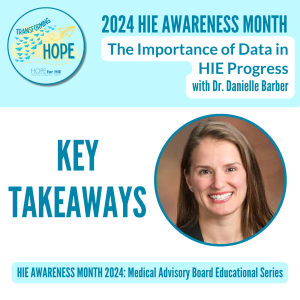
Our families are all too familiar with the agonizing “wait and see” game that comes with an HIE diagnosis. The uncertainty surrounding our child’s long-term impacts, outcomes, and quality of life is a harsh reality we grapple with daily. We wait for results, we wait for researchers to uncover new therapeutic interventions, and we wait for data that could offer us hope.
But amidst this waiting game, there exists another, more proactive path to progress—one that Dr. Danielle Barber illuminates in her recent discussion with Hope for HIE. By harnessing patient-family input and clinical data, we have the power to drive meaningful change in our understanding and management of HIE.
Missed the live stream Q&A? No worries. We took notes, and like any good partner, we are willing to share! Read our key takeaways below.

One of the most notable advancements has been the widespread adoption of therapeutic hypothermia (TH), a practice that was once a clinical trial and is now considered standard of care. TH, administered within the critical window of the first six hours after birth, has reduced mortality and disability among infants with moderate to severe HIE.
While this intervention has become a cornerstone in HIE management, the past decade has also seen a concerted effort to expand beyond its limitations: some studies have explored avenues such as deeper and longer cooling periods or delayed treatment initiation, yet they found that deviating from the standard regimen yields very few, if any, benefits.
Another trial — HELIX — aimed to assess whether therapeutic hypothermia, which had shown promising results in high-income settings, would provide similar benefits in low and middle-income countries with limited access to advanced medical care. These findings revealed no significant advantage of this intervention and, instead, highlighted the need for more tailored approaches to HIE management that account for the unique challenges faced in resource-limited environments.
While therapeutic hypothermia represents a significant leap forward, it’s not a cure, and it’s not entirely equitable: not all families from a geographical standpoint have access to it, and not all infants with HIE are candidates for it. Even with its application, many still experience long-term impairments and disabilities.
So, the quest for effective treatments must continue.

Why this shift? Well, it’s cyclical, and it’s symbiotic. The more our HIE families are engaged, the more information we have to raise awareness about our community’s top unmet needs, and the more researchers investigate and work to address the complexities of HIE. It’s all about a dynamic exchange of knowledge, insights, and experiences.
Here’s the perfect example to demonstrate this relationship: in 2019, Hope for HIE partnered with Trend Community to identify what our families viewed as the most significant gaps in research, literature, and clinical care. At that time, we engaged with 4,500 families, a number that has since doubled over the span of just five years. The insights gleaned from this collaboration highlighted key areas of concern, including seizures and epilepsy, sleep disturbances, and the stress and anxiety associated with parenting children with HIE.
Fast-forward five years, and providers are reaching out to collaborate and address these pressing issues head-on. Recently, we distributed a survey developed by Dr. Renee Shellhaus, a neonatologist and a leader in studies of sleep and sleep-disordered breathing and their impact on neurodevelopment in high-risk newborns, to examine sleep disorders in our HIE children from the NICU through the first few years of life. This is one of many direct responses to the community data collected years ago. Now, with a global community of over 10,000 families, there’s a chance to continue this ongoing dialogue and tune into the evolving needs of those impacted by HIE.

When we say negative, we don’t mean it in the way we look at our mothers-in-law; in the context of a clinical trial, one deemed negative is one in which the experimental intervention did not produce the intended results, as initially hypothesized.
Researchers are also looking to some previous studies, like the HEAL study, which aimed to assess whether administering EPO could improve neurological outcomes of HIE, to inform secondary analyses. While the HEAL study was considered a negative trial, it has offered researchers the groundwork to drive further research based on data collected directly from our community’s involvement: they’re examining various aspects, such as MRI and EEG data, potential genetic influences, medication utilization patterns, and correlations with socioeconomic factors, and they are doing so with a cohort of 500 babies, making it one of our largest in HIE research.
So, while not every trial yields a novel therapy or intervention, it does give us clear answers about what doesn’t work, and that’s still a step in the right direction. And as Dr. Barber explains, these trials wouldn’t be ethical if we knew the proposed treatment’s efficacy, which brings up a great concept to know and understand: clinical equipoise. (Say that five times fast.) This concept is quite long and complex to delve into right now, so for the purpose of this conversation, know this: it essentially involves an International Review Board of providers, researchers, and clinicians who review the trial’s hypothesis and methodology to ensure that patients are not exposed to unnecessary risks and that the research is conducted with integrity.
Long story short, clinical trials that meet clinical equipoise, no matter their results, are examples of good science working well.

The gaps exist. We know they do. So much of our medical literature in HIE focuses on short-term outcomes, typically within the first 2-to-5 years of life. But there’s a wealth of brain development that occurs beyond this timeframe. Many studies rely on outcome measures such as scores on the Bayley’s test, which, while valuable, may not capture the full spectrum of meaningful outcomes for our families.
So researchers want to know: what matters most to you as a parent? Is it whether or not your child will require educational support? Does it involve knowing which, if any, functional impairments they might face? There are researchers out there, Dr. Barber included, who are eager to align their investigations with the priorities of our community, ensuring that the outcome measures they focus on resonate with the experiences and concerns of families affected by HIE.

Enter the idea of an HIE registry. Drawing inspiration from successful patient advocacy models used by the Cerebral Palsy Research Network, efforts are underway to lay the groundwork for a tool complementary to their MyCP, if you’re familiar with it.
Like this platform, My HIE would allow families to provide data on various aspects of living with HIE, including medical history, treatments received, functional abilities, impacts and outcomes, and quality of life measures. This patient-family data would then be combined with clinical data, like medical records, released with your consent. This information, gathered from medical centers across the globe but consolidated and synthesized in one place, would help researchers better understand the diverse needs and challenges faced by individuals with HIE and guide efforts to improve care and outcomes for our population. Ah! The efficiency! The organization!
The registry’s initial phase focuses on two clinical sites, where data is currently being collected from families who opt-in from the NICU and will be followed throughout their children’s neonatal course. Once these bones are built, the goal is to expand to additional clinical sites, broadening the scope of research and increasing opportunities for intervention and tracking of outcomes.

Loss families may question their place within the research community and the registry. Believe us when we say that ensuring your role in advancing research weighs heavily on our minds and drives much of our decision-making.
As Dr. Barber explains, families can honor their child’s memory by contributing their story to the registry. In return, this will help researchers identify children at higher risk for life-ending complications later on and potential interventions that can mitigate these risks.

That place is Hope for HIE’s Clinical Hub. It brings together the best resources we know of, reviewed by our Medical Advisory Board, to help the HIE community understand as much as possible about participating in research and potential treatments, medications, therapies, and interventions aimed at improving the quality of life for children and families impacted by neonatal and pediatric-acquired Hypoxic Ischemic Encephalopathy.
As you look to this resource to provide you with tangible hope for additional therapeutics and changes in clinical care, remember that these advancements cannot happen without the active involvement of our community.
To watch the full live stream, visit our YouTube channel below, or click on our Key Takeaways for an at-a-glance view of this session!
Connect with families, read inspiring stories, and get helpful resources delivered right to your inbox.